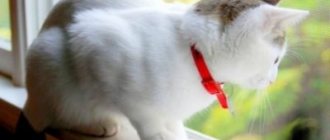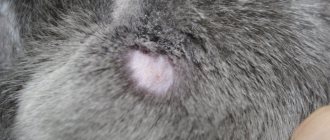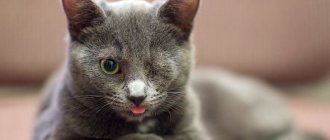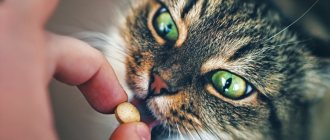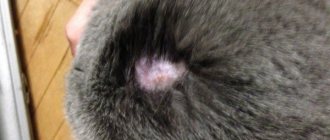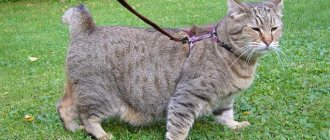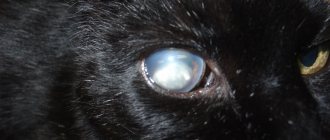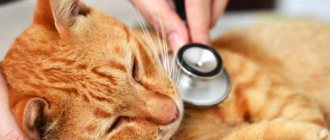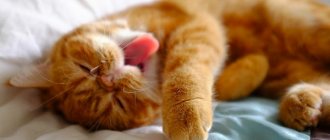Ringworm is a fairly common disease among pets that is caused by fungi. It is dangerous not only with discomfort, but also with serious consequences for the body. The fact is that open wounds on damaged areas are a kind of “window” for bacteria and microbes to enter the pet’s body. That is why it is so important to determine the type of disease in time and prescribe the correct treatment. Today you will find out what types of lichen are found in pets, what lichen in a cat and how to treat it.
Causes of the disease
The main cause of the disease is infection with fungi, which are the causative agents of lichen. The following reasons contribute to this infection:
- The immunity of a small kitten is not fully formed.
- Too early weaning from the mother's breast. Breast milk contains many antibodies that strengthen the offspring's immunity.
- Malnutrition weakens the body. At the same time, the kitten does not have to be street; the weakest kittens in a large litter can be malnourished.
- Keeping animals in inappropriate conditions. Cold and dampness negatively affect the body's resistance.
- Presence of diseases. A sick kitten is an easy victim of any infection, including lichen.
- Lack of necessary hygiene.
Sometimes the disease occurs in well-fed and well-groomed pets, so it is very difficult to predict its occurrence.
How to identify ringworm in a cat?
How to determine ringworm in a cat with maximum accuracy? There's a slight catch here. Of course, externally you can assume the presence of the disease. However, this is not enough - to officially confirm the diagnosis, you need to take the cat to the veterinarian. High-quality diagnosis is the key to proper treatment. After all, there are enough types of lichen, and each of them requires a special approach to therapy.
Symptoms of lichen in cats:
- the animal has spots on its skin with smooth, clearly defined boundaries (as a rule, they have a regular outline);
- the cat’s immunity decreases, which can manifest itself in decreased appetite and activity, apathy, drowsiness, etc.;
- bald patches are not overgrown (or overgrown too slowly) with hair;
- severe hair loss that does not coincide with the animal’s molting period;
- dandruff;
- the cat itches (maybe even until it bleeds).
The appearance of lichen can easily be confused with an allergy. To prevent this from happening, remember that with an allergic reaction in the affected areas of the skin, cats also experience serious swelling and rashes.
Diagnosis of lichen
Just a few years ago, one of the most universal ways to diagnose lichen in kittens was a special ultraviolet lamp, or, as it was called differently, a Wood’s lamp. However, today it is used less and less. The fact is that the Wood's lamp does not always show the correct result:
- only 50% of fungal diseases can be seen with ultraviolet radiation;
- often the UV radiation of the lamp shows other infections that can be confused with lichen;
- Sometimes a weak lamp can illuminate not only the fungus, but also the remains of dirt on the skin and fur of the animal, which calls the diagnosis into question.
Today, veterinarians offer a more modern way to identify signs of lichen in cats. The most accurate research method is tissue sampling. The veterinarian carefully removes the tissue for damaged areas of the pet's skin or fur. Afterwards, an analysis is carried out to not only determine the presence of lichen, but also to identify its specific type.
Which breeds are more susceptible
Most often, kittens living in groups are affected, for example, in nurseries or shelters; street animals become infected from each other. Pets can also get sick, having become infected, for example, from a mother cat or even from their owners, especially from small children.
Although shingles can affect all breeds equally, it is believed that kittens of long-haired breeds are most susceptible to the disease. This is due to the fact that under long fur the infection may be less noticeable.
Injections for lichen
DermicocideInjectable antifungal drug, active against microsporia and trichophytosis.
|
Main symptoms
Round or oval spots appear on the animal's skin, devoid of hair. Most often, the disease begins in the ears, muzzle and paws of the kitten.
As the disease develops, granulation and peeling of the surface of the lichen appears, and severe itching also develops, so the kitten can scratch and lick the sore spot, further spreading the disease or introducing a bacterial infection into the wound with its claws.
Ringworm has a long incubation period - up to three months, so it can be asymptomatic for a long time. The presence of long, fluffy fur further complicates the detection of the disease.
In total, doctors distinguish 5 types:
Ringworm
A group of two diseases - trichophytosis and microsporia, caused by a microscopic fungus. Features of ringworm are highly contagious, both for other animals and for humans. A severe form of the disease can cause vision loss and death.
The main danger of lichen is due to the viability of fungal spores in any conditions for up to 2 years. The development of the disease occurs when the spores are exposed to favorable conditions. When an animal is infected, the incubation (hidden) period of the disease can last up to 2 months. Most often, symptoms appear on the face, ears, limbs, and tail. Sometimes the disease affects the animal's claws. Ringworm is considered the most dangerous and contagious.
Infection occurs as follows:
- upon contact with a sick animal;
- from an animal that is not sick itself, but is a carrier of spores of these fungi;
- when using household items, bedding, toys, hygiene items contaminated with spores;
- household method (brought by the owners on the soles of their shoes).
Ringworm most often appears in a stray cat with a weakened immune system, or in a female cat after pregnancy and childbirth. Kittens and older cats and animals with damaged skin are vulnerable to the disease.
Pityriasis versicolor (variegated)
A disease of the upper layer of the skin caused by a yeast-like fungus of three different forms. This yeast is opportunistic. They are present in the body of even a healthy cat. Under certain conditions, their number increases significantly, which causes the development of the disease.
Pityriasis versicolor is not difficult to detect. This is evidenced by the presence of a small oval-shaped spot, light brown or pink in color. Characteristic of this type of disease is damage to the superficial layer of the skin. It is expressed in abundant scarring and peeling. Itching may be completely absent.
Pityriasis rosea (lichen of Zhibera)
Infectious, presumably viral disease. The probable causative agent is herpesvirus.
The danger of pityriasis rosea lies in its development against the background of reduced immunity, often during the off-season.
At the beginning of the disease, a single spot with a clear outline, pink color, and signs of peeling can be observed. As it develops, this area becomes covered with a dry crust . The number of spots increases sharply, the spots spread along Langer's lines. The damage to the skin becomes significant and generalized.
No special treatment is required. Pityriasis rosea disappears on its own.
Lichen planus
A disease whose cause lies in the functioning of the immune system. Failures of the immune system are a trigger for the enhancement of the following factors:
- infections,
- chronic diseases,
- influence of external factors.
It is characterized by the appearance of small plaques with a shiny surface. The color is sharply different from the surrounding skin, from red-pink to brown-bluish. In the center of the nodules there may be a depression or transverse striation. As the disease progresses, the lichen merges into a large lesion .
Lichen planus
This type of disease has a different localization from other types. Located on the joint folds, abdomen, and groin area. If the cat is itchy, exudate is released from the plaques.
Ringworm (eczema)
The cause of the disease is complex; it is based on disturbances in the functioning of the nervous and endocrine systems of the animal’s body, and a general weakening of the immune system. An impaired immune response leads to the development of damage and inflammation of the skin. This disease is not contagious.
This type of lichen is manifested by the appearance of compacted areas of pink-red skin, with blisters and pustules on the surface.
The hairs on these spots are missing or broken off. After opening the vesicles, oozing wounds remain, which are very painful. The disease is also accompanied by severe itching, fever, and deterioration in general health. It must be treated.
Treatment method and prognosis
Most cats with ringworm are treated on an outpatient basis, so home treatment, provided it is done correctly, is quite acceptable. It is only important to follow the doctor’s recommendations, because some techniques cannot be applied to small kittens.
The easiest way to treat is to use special shampoos. The kitten is washed with them twice a week for 6 weeks to completely eradicate the infection. You should only use a specialized antifungal veterinary shampoo approved for kittens.
If there are only isolated lesions on the animal's body, you can use antifungal ointments or sprays. The kitten is treated in this way for a week and a half, lubricating the wounds twice a day.
At home, lichen is often treated with sulfur ointment, treated with celandine juice, and cauterized with iodine or brilliant green.
With timely treatment and proper care, it is possible to achieve a good result and rid the animal of infection, but procedures must be started as early as possible.
Prevention
In order not to have to treat a disease, it can always be prevented. In the case of lichen, prevention consists of several measures:
- Keep your cat away from outdoor animals that show signs of lichen.
- Disinfect the house. Chlorhexidine is ideal for this. With its help, it is necessary to treat all surfaces (tables, chairs, window sills, chests of drawers, upholstered furniture, tablecloths, kitchen textiles).
- If your cat has had shingles, be sure to replace all of his toys, bed, clothes, collars and other personal items.
- Try to prevent the animal’s immunity from weakening. To do this, it is important to choose a balanced diet for your fluffy and provide regular walks and activities. If you feed your cat natural food, be sure to include a complex of vitamin supplements in the menu. A strong body with good immunity is more resistant to the appearance of lichen and, even in case of infection, will be able to cope with the disease faster.
- If your cat goes outside, be sure to bathe him using special preventative shampoos.
- There is also a vaccine against shingles. It will not work on cats that are already sick - it is more of a preventative method. Ask your veterinarian about the vaccination schedule and get vaccinated to protect your pet.
For cats with weak immune systems, it is better to completely limit contact with street animals. After all, even without any symptoms, a cat or dog can be asymptomatic carriers of lichen.
What to do at home
At home, the kitten must be isolated from other animals and from children, since lichen is easily transmitted to humans. You will have to wear gloves to treat wounds and bathe him, wash your hands especially often, and treat the room with antiseptics.
You should not allow your pet into bed; its bed must be frequently disinfected or the bedding changed, since fungal spores remain alive for a long time and can become a source of re-infection.
The kitten needs to be well fed and kept warm. An “Elizabethan collar” will have to be put on his neck so that he cannot lick off medications, most of them toxic, or scratch itchy wounds.
Diagnostics
External signs are not enough to distinguish between fungal and non-infectious types of dermatitis.
The veterinary clinic uses three laboratory methods:
- Wood's fluorescent lamp examination . The rays of the device paint areas affected by fungi green. The method is considered inaccurate: sometimes healthy tissues glow due to the effects of drugs and synthetic detergents, but individual yeast-like microorganisms are not illuminated.
- Microscopic examination . Hairs and skin scrapings from damaged areas are examined under magnification. This method also does not provide 100% accuracy: in sick animals, pathogen cells are sometimes not detected.
- Mushroom cultivation . The method is more reliable than the others, but you will have to wait up to 3 weeks for the results. Skin scrapings are placed in a nutrient solution, changes are observed, and then examined under a microscope.
At the same time, urine, feces and blood are taken from the cat for clinical and biochemical tests, and the state of health is determined.
Possible complications
If the disease is not treated, lichen can spread to large areas of the body and become chronic, causing severe suffering to the small creature. If itching, it can cause a bacterial infection, then you will have to introduce antibacterial agents into the treatment (as prescribed by the veterinarian and taking into account the age and weight of the cat).
Take care of your pets
Detection and diagnosis of the disease in cats is difficult. Pet hair partially hides the affected areas. And the habit of constantly licking oneself masks the itching.
It is better to entrust an accurate diagnosis to a specialist who can differentiate it from similar diseases and parasite infection. Shingles is not typical for cats; it only affects humans . If necessary, special cultures will be prescribed to determine the pathogen. Some types of the disease are contagious to humans.
Do not forget about prevention - vaccination, balanced nutrition, compliance with cleanliness and hygiene measures. After all, responsibility for the health of furry pets lies with the owners.
At the beginning of the disease, a single spot with a clear outline, pink color, and signs of peeling can be observed. As it develops, this area becomes covered with a dry crust . The number of spots increases sharply, the spots spread along Langer's lines. The damage to the skin becomes significant and generalized.
